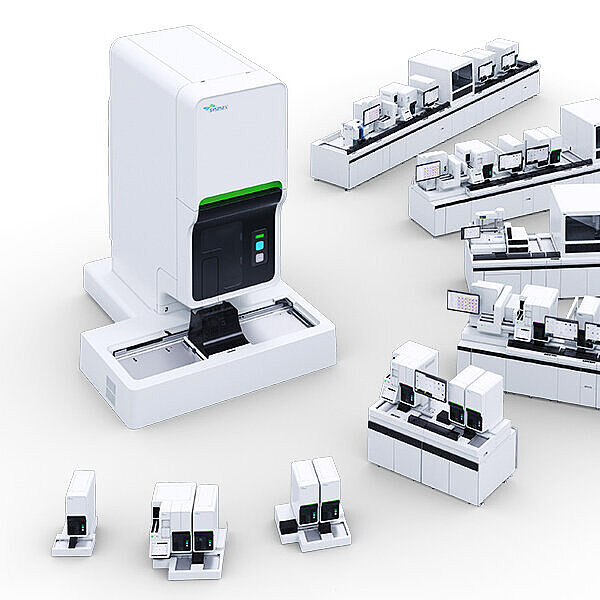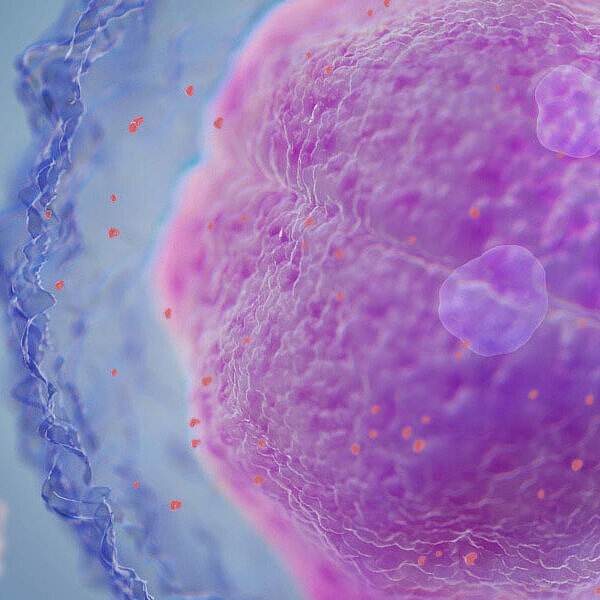Parameters that will become very valuable tracing iron deficiency
XTRA ARTICLE EDITION 2/2019
The parameters Hypo-He, RET-He and Delta-He are useful markers in the diagnosis of anaemia: Two perspectives from clinical and laboratory settings on using the parameters to monitor the supply of iron to the bone marrow
Interview: Ramona El Fatmi
“Parameters that will become very valuable”
The internist and nephrologist Prof. Dr Roland Schaefer on the importance of the RET channel parameters for the diagnosis of anaemia in dialysis patients
Prof. Schaefer, why do dialysis patients often suffer from anaemia?
Renal anaemia has many causes. One key trigger is the fact that the proliferation of erythroblasts in the bone marrow is slowed down by renal damage. Recombinant erythropoietin is administered to stimulate the hypoproliferative bone marrow. Patients lose between two and three grams of iron each year due to dialysis, which has to be compensated. Around 85 percent of haemodialysis patients thus receive an iron supplement, usually intravenously. Of course, a check should also be made as to whether there are other reasons for the anaemia, gastrointestinal bleeding, for instance. But the main causes are erythropoietin and iron deficiency. Haemoglobin and ferritin levels are checked monthly to monitor iron supplementation. Dialysis patients should have haemoglobin levels between 10 to 12 grams per decilitre (g/dL).
What do you believe are the benefits of RET channel parameters (Hypo-He/RET-He/Delta-He) in the diagnosis of anaemia over classic, clinical-chemical parameters?
The RET channel parameters track the iron supply at the bone marrow level. The advantage of this is that the measurement is taken directly where the iron enters the haemoglobin synthesis. Based on ferritin levels the iron store is monitored, but at the end of the day, this does not really tell us anything about the supply of iron at the bone marrow level. The transferrin saturation is rather an indicator of the bone marrow supply. But the transferrin level can be low in dialysis patients because it is also a nutritional parameter: If patients do not eat enough protein, the transferrin level drops. Consequently, the transferrin saturation is not always helpful. What’s more, because a number of dialysis patients have a chronic inflammation, the hepcidin level is very likely elevated and the release of iron from the macrophages is impeded. In other words, the store retains more iron than in someone with healthy kidneys. The direct tracking of iron supply through the RET channel parameters RET-He and Hypo-He, on the other hand, provides us with information about what actually reaches the bone marrow level.
![[.CO.UK-en United Kingdom (english)] Eisenmangel Teil I](/fileadmin/_processed_/c/5/csm_Sysmex_Xtra_2_2019_Eisenmangel_Nephrologie_Dialyse_813e61f12e.jpg)
The consensus paper “Iron management in patients with chronic renal insufficiency” on which you collaborated in 2009 also names the RET channel parameters as being beneficial. How important are these parameters today?
They are in fact no longer of much importance in practice. In Germany, so much iron is now administered intravenously during dialysis that there are hardly any patients with an evident iron deficiency. And in this respect, it has become almost unnecessary to measure the supply of iron at the bone marrow level. This is only beneficial for monitoring the few patients who receive no iron. And let’s not forget that ten years have passed since this recommendation was published.
Can you imagine a field of use for Hypo-He, even though this value is of little relevance for dialysis with current therapy management?
The situation is bound to change. A new class of anti-anaemic drugs is being developed; so-called ‘HIF’ (hypoxia-inducible factor) stabilisers. Put simply, HIF is a transcription factor that is always activated in the presence of hypoxia, whether it is local or systemic in the organism. This transcription factor regulates a number of genes and does everything to improve the transport and availability of oxygen. Amongst other effects, it stimulates the erythropoietin secretion. It also stimulates the expression of erythropoietin receptors on erythroblasts. And, very importantly, it reduces hepcidin so that the iron stores open. As soon as this substance class is approved, we will probably need much fewer iron supplements in the future than we do today. The matter of an adequate iron supply for the stimulated erythropoiesis will almost certainly become more important again, and the RET channel parameters that reflect the supply of iron in the bone marrow will once again become much more valuable for dialysis patients than they are today.
Sysmex determines the share of hypochromic red blood cells using the parameter Hypo-He. The system detects these on the basis of the lower Hb-content in red blood cells. The parameter is therefore extremely stable, even in old sample material. Do you see advantages in this?
Definitely. What’s special about dialysis is that we also take blood samples in the late afternoon or early evening because we perform dialysis in up to three shifts a day. This means that the last patients for the day arrive in the centre at 6 or 7 pm. A blood sample is then taken, but of course it is not collected by the courier service on the same day. Thus, it may take up to 24 hours before the sample is analysed in the laboratory. As a result, it is important to have a parameter that is relatively stable. The haemoglobin content is independent of the hydration status of red blood cells. When it comes to hypochromic red blood cells, other systems measure the haemoglobin concentration in the cell. And this falls over the storage period, so that the measured haemoglobin concentration tends to be lower after a longer period of storage. In this respect, the Hypo-He level has a big advantage for dialyses because this parameter remains stable.
Summary
- RET-He and Hypo-He are two factors that can be used to monitor iron deficiency in dialysis patients.
- They track the supply of iron directly at the bone marrow level and are particularly stable.
- The parameters could also be relevant for a new class of anti-anaemic drugs, so-called ‘HIF’ stabilisers.
Photo source: Marian Lenhard

